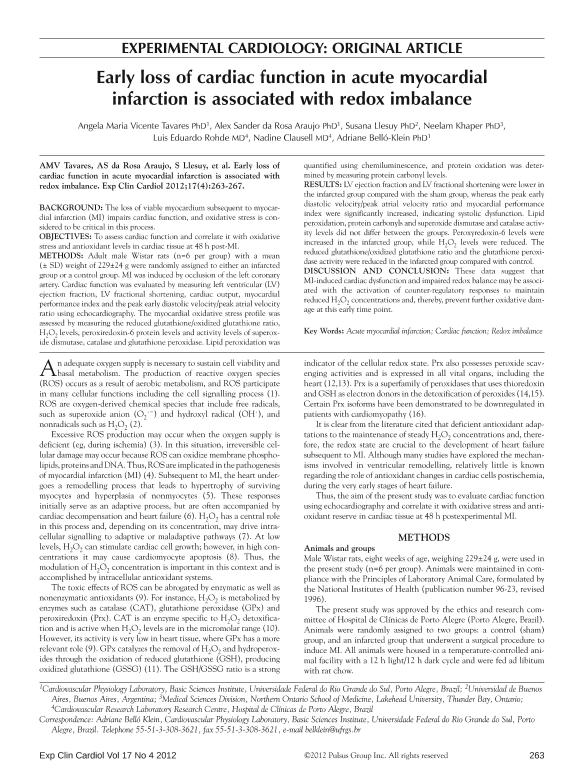Artículo
Early loss of cardiac function in acute myocardial infarction is associated with redox imbalance
Vicente Tavares, Angela María; da Rosa Araujo, Alex Sande; Llesuy, Susana Francisca ; Khaper, Neelam; Rohde, Luis Eduardo; Clausell, Nadine; Bello Klein, Adriane
; Khaper, Neelam; Rohde, Luis Eduardo; Clausell, Nadine; Bello Klein, Adriane
 ; Khaper, Neelam; Rohde, Luis Eduardo; Clausell, Nadine; Bello Klein, Adriane
; Khaper, Neelam; Rohde, Luis Eduardo; Clausell, Nadine; Bello Klein, Adriane
Fecha de publicación:
12/2012
Editorial:
Pulsus Group Inc
Revista:
Experimental Cardiology
ISSN:
1205-6626
Idioma:
Inglés
Tipo de recurso:
Artículo publicado
Clasificación temática:
Resumen
BACKGROUND: The loss of viable myocardium subsequent to myocardial infarction (MI) impairs cardiac function, and oxidative stress is considered to be critical in this process. OBJECTIVES: To assess cardiac function and correlate it with oxidative stress and antioxidant levels in cardiac tissue at 48 h post-MI. METHODS: Adult male Wistar rats (n=6 per group) with a mean (± SD) weight of 229±24 g were randomly assigned to either an infarcted group or a control group. MI was induced by occlusion of the left coronary artery. Cardiac function was evaluated by measuring left ventricular (LV) ejection fraction, LV fractional shortening, cardiac output, myocardial performance index and the peak early diastolic velocity/peak atrial velocity ratio using echocardiography. The myocardial oxidative stress profile was assessed by measuring the reduced glutathione/oxidized glutathione ratio, H2O2 levels, peroxiredoxin-6 protein levels and activity levels of superoxide dismutase, catalase and glutathione peroxidase. Lipid peroxidation was quantified using chemiluminescence, and protein oxidation was determined by measuring protein carbonyl levels. RESULTS: LV ejection fraction and LV fractional shortening were lower in the infarcted group compared with the sham group, whereas the peak early diastolic velocity/peak atrial velocity ratio and myocardial performance index were significantly increased, indicating systolic dysfunction. Lipid peroxidation, protein carbonyls and superoxide dismutase and catalase activity levels did not differ between the groups. Peroxyredoxin-6 levels were increased in the infarcted group, while H2O2 levels were reduced. The reduced glutathione/oxidized glutathione ratio and the glutathione peroxidase activity were reduced in the infarcted group compared with control. DISCUSSION AND CONCLUSION: These data suggest that MI-induced cardiac dysfunction and impaired redox balance may be associated with the activation of counter-regulatory responses to maintain reduced H2O2 concentrations and, thereby, prevent further oxidative damage at this early time point.
Palabras clave:
Acute myocardial infarction,
,
Cardiac function,
,
Redox imbalance
Archivos asociados
Licencia
Identificadores
Colecciones
Articulos(IBIMOL)
Articulos de INSTITUTO DE BIOQUIMICA Y MEDICINA MOLECULAR
Articulos de INSTITUTO DE BIOQUIMICA Y MEDICINA MOLECULAR
Citación
Vicente Tavares, Angela María; da Rosa Araujo, Alex Sande; Llesuy, Susana Francisca; Khaper, Neelam; Rohde, Luis Eduardo; et al.; Early loss of cardiac function in acute myocardial infarction is associated with redox imbalance; Pulsus Group Inc; Experimental Cardiology; 17; 12-2012; 263-267
Compartir



